Featured within the Art of Glass exhibition is Erin’s latest body of work Chinese Whispers.
The title alludes to the childhood game where, as the Collins Dictionary describes, “…a message is passed on, in a whisper, by each of a number of people, so that the final version of the message is often radically changed from the original”.
Erin was interested in investigating how the translation, or mistranslation of glassmaking techniques and methodology changes across the globe. And in turn how an individual artist’s own interpretation and their understanding of production shapes an outcome with no visual stimulus to guide them.
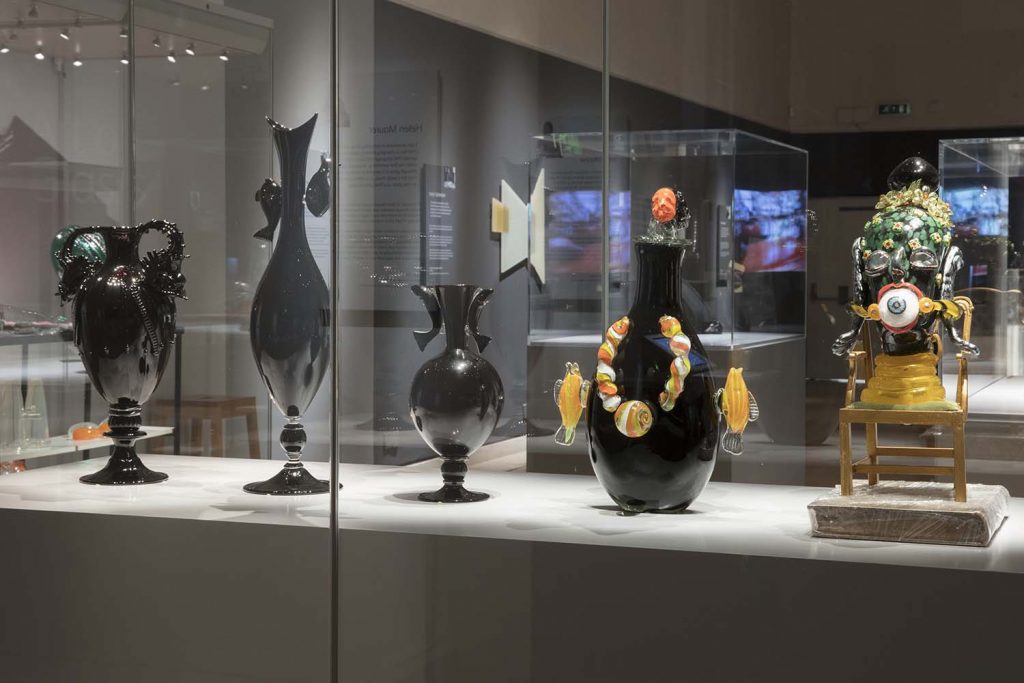
Following a visit to the Murano glass Museum in 2015, Dickson was taken by a wonderful Venetian vessel. The Venetian island of Murano is famed for its glassblowers and its very unique style of production. So famous were the glassblowers of Murano that to keep their secrets a glassblower would have had to lose a hand before they could leave the furnace they worked for and the island.
Today thankfully, the measures to keep its secrets are not as extreme, and artists from across the globe look to train there to understand the Venetian techniques. The Venetian style has been copied across the globe, most notably the American artist Dale Chihuly is known for his large installation artwork that is created in his American Venetian hybrid glassblowing style.
It was at this point that Erin considered how this global translation has changed, and on the idea for the project. She envisaged that a set of instructions would be written by each glassblowing maestro she would collaborate with, and that they would be then translated into the native language of the next. Each glassblowing maestro would be asked to produce a blown object in black glass in their understanding and interpretation of the instructions provided. They were then to write 100 of their own words to describe their process, which would then be passed on.
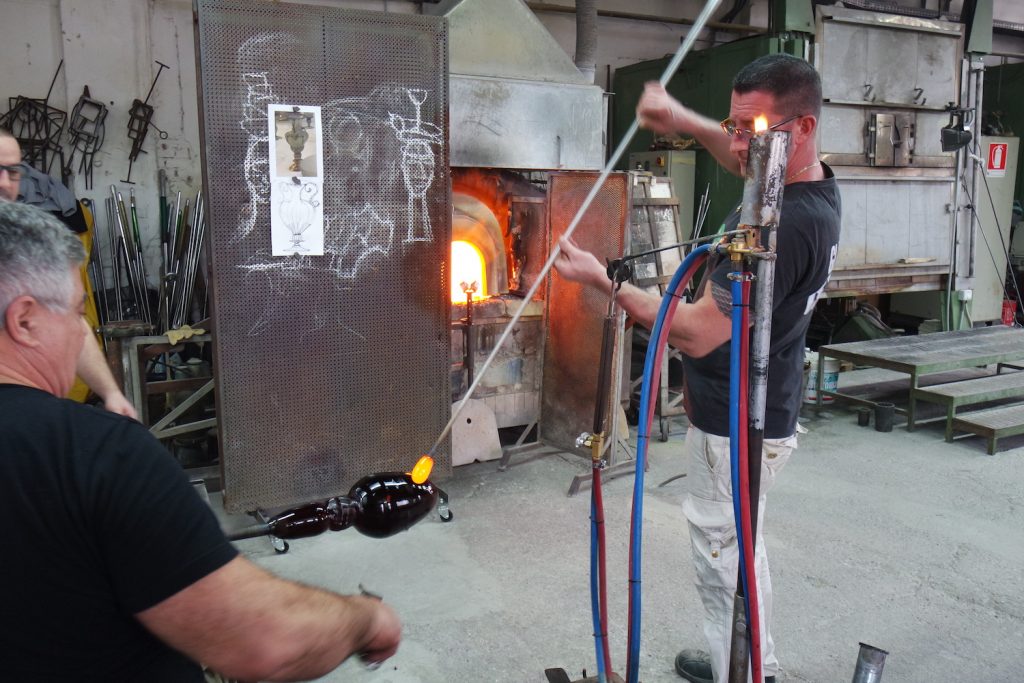
Collaborating with the Venetian master glass blower Silvano Signoretto, she asked if he would create a reproduction of the piece she had seen in the Museum in Murano. Silvano, a master glassblower who has been working with glass since the age of eight, created a faithful reproduction of the historical piece, and this became the starting vessel for the project.
His instructions, the initial whisper, are when you read them technically brief. There is little to direct you to apply a venetian style or decoration. In the translation you can see that he assumes the reader will have a knowledge and understanding of glassblowing methodology. But without a visual reference to guide the next master glassblower, it is left open to the next maestro’s own artistic interpretation.
“Ho fatto prima i 2 pesci e li ho messi in tempera a 600 gradi dopo ho preparato il culo del vaso ho applicato la palla. Il piede ho ataccato il puntello e pass
Ato il tutto sul puntello in modo da poter fare il bevante una volta finito il bevante (la bocca) mi hanno riportato ii pesci e con un po di vetro caldo li ho attaccati sul collo del vaso.” *
“I did the first two fish and put them in at a temperature of 600 degrees after I made the butt of the vase I applied the ball. The foot I attached the shore and pass to all on shore so you can make the rim points once finished the rim points (his mouth) I have reported two fish and with a little hot glass I attacked them on the neck of the vase.”
Silvano Signoretto, Berengo Studios, Murano, Italy
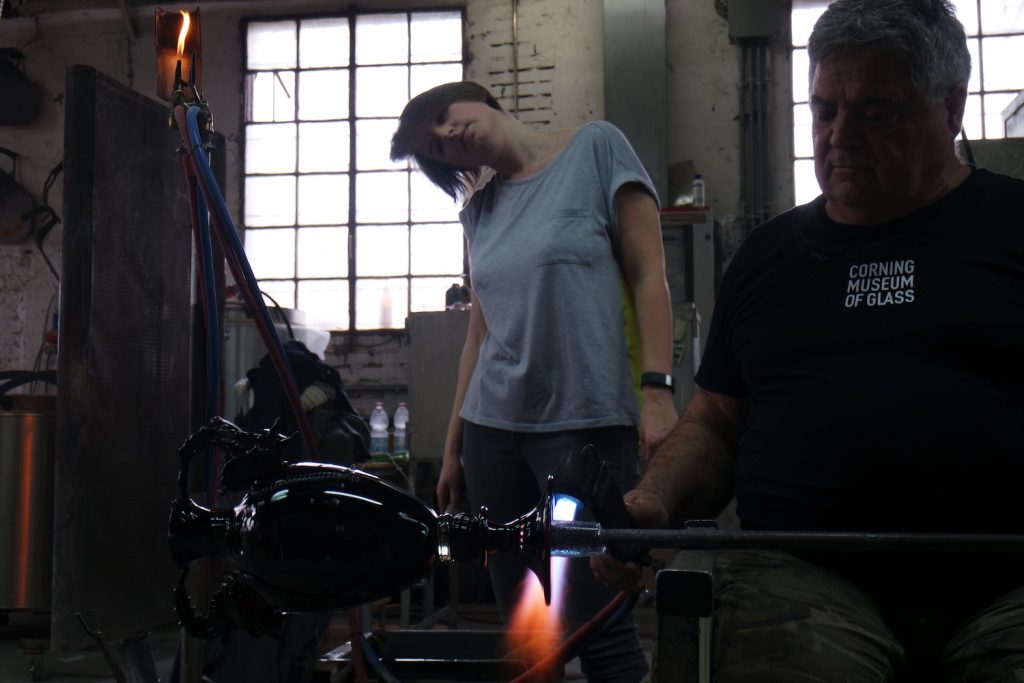
So, this very minimal set of instructions were forwarded to the British glassblower James Devereux, the first recipient within the Chinese Whisper. Using his own intuition and understanding of glassblowing, James created a tall elegant vessel, with a similar foot, but the fish handles have now become a decorative feature and as none of the Venetian decorative finishes were mentioned, the finish is much more paired back. Interestingly when James saw Signoretto piece in comparison to his own, he wanted to do it again. However, that would have been a false response to Erin’s project. Her aim is to discuss how translation, both personal and terminologically, has changed across the globe regardless of the result.
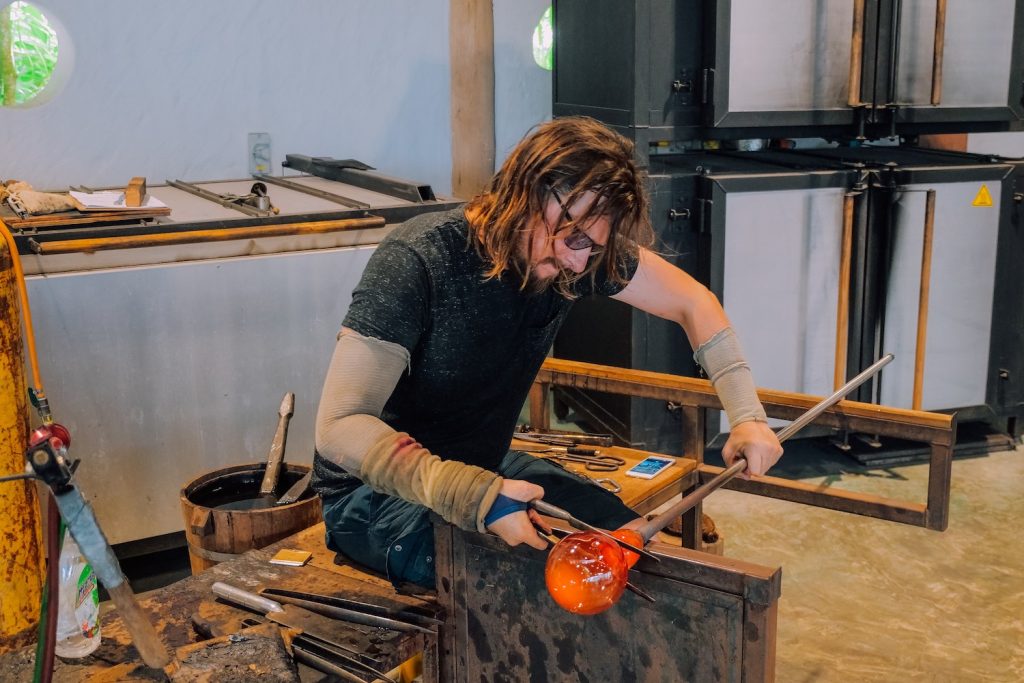
From Wiltshire Erin sent James’s instructions to Hyunsung Cho in South Korea.
“I began by making two fish and kept them warm. I then dropped out the body of the vase followed by adding a ball then the foot of the vessel. After this I transferred the piece and finished the rim with two points. Finally, I attached the fish to the neck of the vase with a small bit of hot glass. finished and away.” *
“나는 두 마리의 물고기를 만들어서 따뜻하게했습니다. 나는 그 다음에 화병의 몸을 내리고 그 다음에 공의 발을 넣고 배의 발을 넣었다. 이 후 나는 조각을 옮기고 2 점으로 테두리를 완성했다. 마침내 나는 뜨거운 유리 잔으로 꽃병의 목에 물고기를 붙였다. 끝내고 멀리.” *
James Devereux, Devereux Huskie Glassworks, Wiltshire, UK
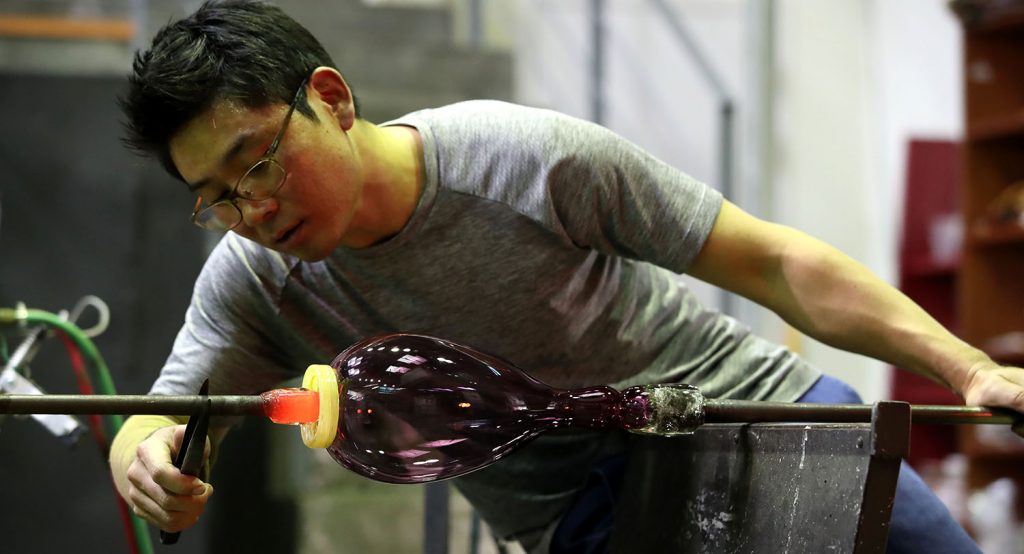
Cho response was to create a squat, almost moon jar shaped body, with a short-extended neck, and again with the fish as a mere decoration to the neck. Ironically Cho trained within the American Venetian techniques whilst working in the states at Pilchuck Glass School, Stanwood. However, within his response to James instructions, Cho’s personal interpretation of a footed vessel reflects his training in both western and eastern glassblowing techniques, allowing for the creation of a very minimal but aesthetically western idea of an eastern traditional vessel.
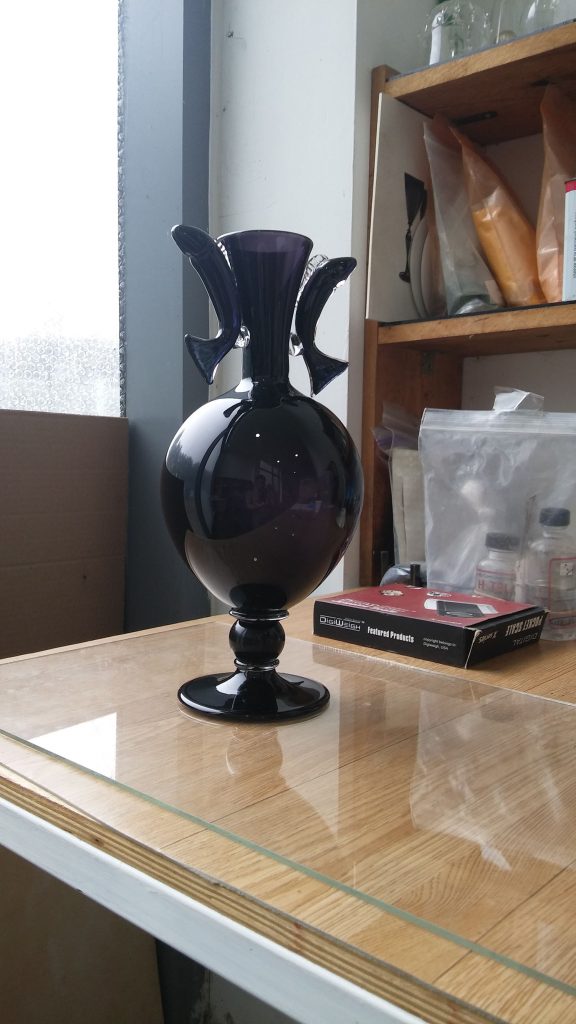
From South Korea Cho’s instructions were sent to SibusisoMhlanga in Swaziland.
“나는물고기두마리를만들어서따뜻한상태를유지시켜주었고구슬 형태에평평한바닥에놓을수있도록발을달아주었다. 그리고천천히식혀주었다. 그후목이긴형태를만들고위아래를바꾼뒤미리만들어둔물고기두마리를마치손잡이처럼병의목에붙여주고천천히식혀주었다. 그후미리식혀놓았던아래부분을몸통과접착제를이용해붙여주었다” *
“Ngamnika igcina isimo efudumele ngokwenza nezinhlanzi ezimbili Ngakho noteulsu phezu flat ngesimo ubuhlalu abalekile izinyawo zabo. Kwasekubikwa selehlile kancane. Khona-ke ukudala amafomu eside-lukhuni akunika nezinhlanzi ezimbili unamathisele wena okwenziwe ngaphambilini ushintshanisiwe emuva phansi sengathi entanyeni ibhodlela sengathi ikhanda kancane Kwaba cool. Khona-ke wanika phansi notatdeon ngaphambilini selehlile unamathisele emzimbeni kanye ingcina” *
“I gave him a warm atmosphere by making two fish so noteulsu over flat with the shape of beads that left their feet. It was reported slowly. Then create long-hard forms give you two fish to paste you made previously backed down as if the neck on the bottle as a little head for cool. Then he gave down the tastonon before it had gone down and attached to the body and the stomach” *
Hyunsung Cho, Glass Island Museum, Ansan, Korea
When you read in English how the structure of the translation from Korean to Swati changes, you understand how the fourth iteration in the series is now starting to morph into something different. Sibusiso’s interpretation of the instructions has changed the outcome from a footed vessel to a stoppered flask. This flask also incorporates bead and trailed decoration in white and orange, and the stopper is a diminutive head, which we can only assume is a reaction to the “little head” mentioned in the translation.
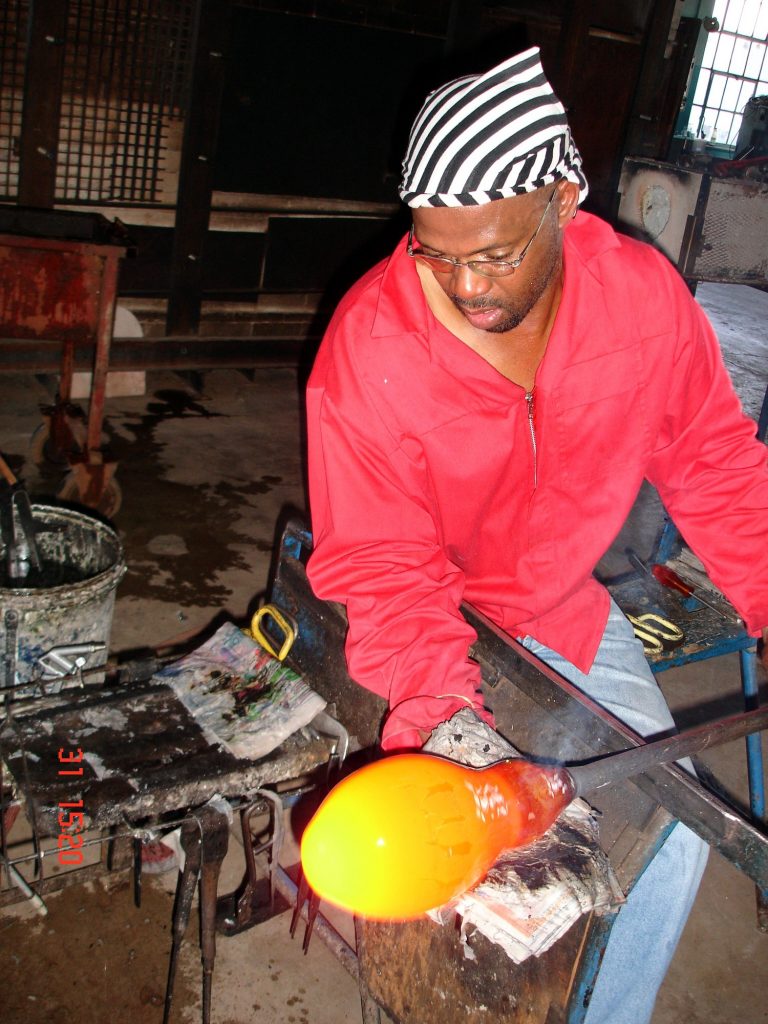
Sibusiso’s personal interpretation brings in colour and a new form, with his approach being much more organic. It is at this juncture and through Sibusiso instructions to the next collaborators, the Mexican brothers Einar and Jamex De La Torre, that we see an exciting change to the Chinese Whisper.
“Ngasebentisa lipayiphi, ngatapuna ingilazi. Ngayiphuphutsa lokusa bhola ngakwenta kwaba nentsamo. Ngaku mancata emaleleni kuhle kwenftombi yeu Swati kuma kwayo. Kwaba nemfanekiso wemuntfo emlonyeni wako. Ngase nginku gabisa buhlalu kwaba netinhlanti letimbili emaceleni” *
“Utilicé un tubo, y tomé un vaso. He escuchado la pelota y he hecho mi cuello. Esto es una mirada fantástica en el soporte de la muchacha de Swati. Había una foto de alguien en su boca. A continuación, el cordón afeitado con dos peces en los lados.” *
“I used a tube, and I took a glass. I listened to the ball and made my neck. This is a fantastic look at the stand of Swati’s girl. There was a picture of someone in his mouth. Next, the shaved cord with two fish on the sides.” *
Sibusiso Mhlanga, Ngwenya Glass, Swaziland
It was his instructions and the translation into Spanish that creates a new more spiritual and cultural dynamic to the approach. The result of which is a seated Mexican demigod clasping an all-seeing eye in its mouth and the importance of women in art in the book it sits upon. The De La Torre brothers are internationally renowned for their playful expressive glass sculptures that reference Mexican culture and religious iconography. This piece takes the series completely away from the vessel form in which it started, to a new figurative sculpture with only the fish remaining to link back to Silvano’s.

Erin’s project is a fascinating exploration on how a reproduction of a traditional Venetian vessel can be completely lost through a series of reinterpreted instructions. The Chinese Whisper in its brevity has now become something less technical. With only a limited number of words to play with, the master glassblowers instructions have moved towards a more interpretive form of communication. The journey it is now taking regarding future collaborations is exciting. Who knows where the instructions will journey too next, and how that individual will interpret them. We are left wondering if the fish, the sole original decorative element, will remain intact, or if they too will disappear.
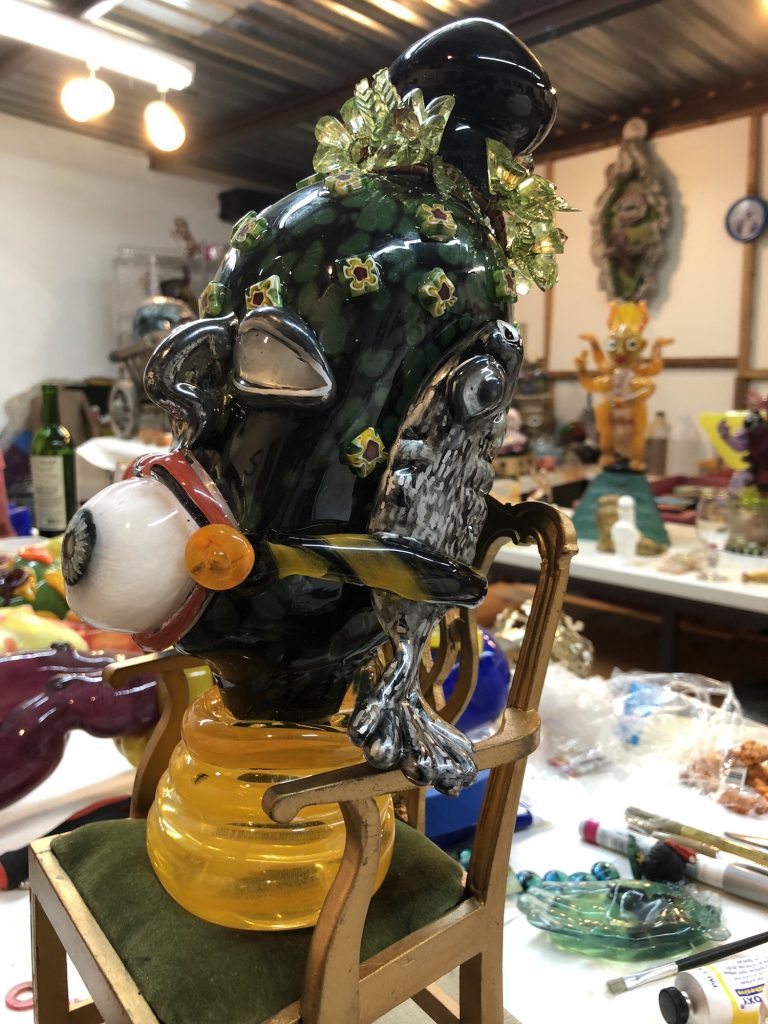
#ArtofGlassExhibition in partnership with

The Art of Glass exhibition is on at the National Museum of Scotland until 16 September 2018 and follows two years of research and development funded by Art Fund Jonathan Ruffer Curatorial Award.
Art of Glass on film https://www.nms.ac.uk/artofglassonfilm
* Please note translations generated by ‘Google’.
